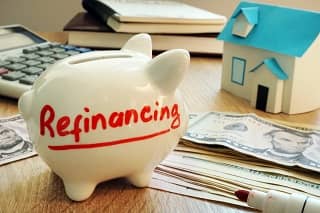Underwater Crisis: One Solution, Perhaps
In the present economic climate, it's getting harder for millions of people who want to remain responsible homeowners. Frankly, as things stand now, there's little financial incentive for them to continue to behave responsibly, and plenty of potential benefit should they decide to behave badly.
Here's why. Economic and market conditions beyond anyone's control have eroded home values. As a result, far too many people are trapped in homes worth less than the mortgage amount they borrowed. Although there have been some half-hearted solutions proposed (including such notables as the Home Affordable Refinance Program, or HARP), very few underwater but honorable homeowners will get any help in alleviating their budgetary stress. For the majority of homeowners who are current but "underwater" and so cannot refinance, there are no programs available from either the private market or the government to help.
Although no assistance is coming your way, you're being asked to "step up" to help "less fortunate" homeowners get "affordable" loans, and you're expected to cover the costs of bailing out Wall Street, megabanks, General Motors. You are even being asked to backstop Fannie Mae and Freddie Mac, the now-taxpayer-backed firms that own or guarantee mortgages. As time goes on, it's increasingly clear that the "reward" for doing the right thing and paying your obligations faithfully and on time will come not in the form of any support, but rather huge future tax bills.
You know that the Federal government's involvement in the housing market crisis has been deep and wide. What you might not know is that it is probably insufficient.
Low mortgage rates have proven to be little more than a beautiful mirage to homeowners who have no equity in their homes or who are underwater. If you're one of them, you cannot refinance to recast your household balance sheet and cannot sell without generating a loss, some (or all) of which you will need to pay out of pocket.
It has also become increasingly apparent that before the housing market and the broader economy can move forward, new solutions to the "underwater" issue must be considered. If we are going to spend billions of taxpayer dollars to keep people in homes they cannot afford, shouldn't we also consider some form of program for people who want to remain in their homes and behave honorably, but who -- through no fault of their own -- cannot take advantage of the lowest mortgage rates in more than 50 years, and are missing perhaps the best chance ever to lighten their financial burden?
The idea of widespread "principal reduction" continues to be floated in the market, most recently when a rumor circulated that Fannie Mae would begin such a program at the direction of the administration. While it was probably only a trial balloon to test market reaction, millions of homeowners remain trapped in loans that exceed the value of their homes and who could benefit greatly from the kind of budgetary improvement that mortgage refinancing provides.
It's our opinion that the failure to develop any response to this "underwater and can't refinance" problem exacerbates the "strategic default" problem and also likely ensures that the issue of lender loss via "short sale" will be with us for many years to come.
We've taken some time to more deeply consider the "underwater and can't refinance" problem and think we've got a practical solution for many people trapped in this situation. It goes without saying that not all borrowers can be made whole through any government program, but at least some can. Our "value-to-price gap coverage" ("value gap coverage") concept would be aimed solely at borrowers who are still current on their mortgages, have every intention of remaining so and hope to remain in their homes for the foreseeable future.
Perhaps the most controversial idea in what follows is that we absolve the borrower of responsibility for any deficiency. If a borrower did not cause a decline in his or her home's value, has been meeting his or her obligations without fail and is now, outrageously, being asked to pick up part of the tab for failed homeowners, he or she ought to get some subsidized benefit for doing the right thing. If it works, there would be a declining cost to the taxpayer over time, with the actual cost of "assistance" possibly falling to zero.
An Idea: Government-Sponsored Value Gap Coverage
No borrower obligation for shortfall or deficiency
We'll start with the simple but controversial premise: At no time will the homeowner be responsible for any deficiency between the value of the home and the dollar amount of the mortgage, at least based upon today's valuations. (An alternate plan, included below, allows for some homeowner participation; continue reading to see how).
Since there is no equity in the home, the refinance will of course not allow the homeowner to take any cash out of the property.
Establishing a "value gap"
Using the current mortgage balance, and weighed against a fresh appraisal of the property, a "value gap" would be established and registered with a government entity, most likely HUD but possibly Fannie Mae or Freddie Mac.
Deferred payment to lender or investor
A "value gap contract" would be executed between the lender/investor and the government entity to cover this differential. This payment would not be made today, but rather deferred to when the property has been sold to another party. As well, this contract's dollar amount (coverage) could be expanded to cover any mortgage insurance needs; this additional premium could be paid into a self-insuring pool or lender-paid MI arrangement.
Refinance particulars
Under this arrangement, the borrower would refinance 100 percent of the present appraised value of the home. This would produce a new mortgage at a 100 percent loan-to-value (LTV) ratio at today's market interest rates, and the refinance would come in the form of a fixed-rate, fully amortizing mortgage with a 30-year term. If the borrower's financials permit them to handle a shorter term, they would be allowed to choose one.
Here's an example:
- Value of mortgage: $180,000
- Value of home: $150,000
- Value gap: $30,000 (about 17 percent "underwater")
- Refinance at 100 percent LTV: $150,000 (plus needed MI coverage, if any).
Lender's benefit
At the time of the loan's origination, lenders or investors would get no additional cash but rather a guarantee that should a deficiency still occur when the property sells in the future, they will be made whole by the government for this established value gap. To produce incentives to participate, and to help ensure fair return, the same market rate for the refinance mortgage should be applied to the value gap contract, so the investor would receive just as much as any fully refinanced loan amount would bring ($180,000 per our example). This interest cost could be borne by the borrower, just as the mortgage interest cost would be.
Government costs decline over time
As time goes on, and home prices eventually recover, the amount of the value gap contract would diminish. This change of the contract value amount would happen at the time an appraisal was conducted in preparation for the home to be sold to another party.
For example, let's say that the home was sold 12 months after a "value gap refinance." If the home's value has appreciated by 3 percent in the year after the value gap refinance was executed, the value of the home would have improved to $154,500. The full proceeds from the sale -- $154,500 -- would be paid to the investor; because the value gap was made smaller by market appreciation, the dollar amount of the value gap coverage would be reduced by a like amount. As such, the value gap contract holder (government) would be responsible to make up a differential of just $25,500.
Borrower's benefit
In exchange for the ability to refinance to a new mortgage with a lower face amount and a present-market interest rate, the borrower gives up rights to future appreciation -- but not forever. Any price appreciation would be committed to the value gap until such time as the value of the home once again exceeds the value of the original mortgage (per the example above, $180,000). The borrower would not be responsible for any shortfall, but only for interest payments on the amount of the shortfall.
That is, the borrower would not benefit from any market-based appreciation until the value gap is filled and the liability to the government satisfied. In the example above, the homeowner would develop equity in the property only from the retirement of principal through regular repayment of the loan and not from market appreciation until the value of the home exceeds the original face loan amount.
Creating equity
However, homeowners would create a new equity stake in the traditional manner: by paying down their loan balance though regular amortization. As the borrower slowly retires the outstanding balance of the loan amount created at the time the value gap was established (a refinanced $150,000 per our example), the declining loan balance produces equity in the normal fashion. This of course becomes the borrower's equity stake, free and clear of any obligation.
Should the homeowner hold onto the property for an extended period of time before selling, and should the value gap be eliminated, any amount of money in excess of the original loan amount is the homeowner's, free and clear of any obligation.
Most likely, this would take place over a number of years. Assuming a 3 percent per-year increase in the home's value owing to market appreciation, the calculation would look something like this:
| Value Gap Coverage Example | |||||
| Home value: $150,000; Original Loan Value $180,000; Value Gap $30,000 | |||||
| (Assumes 4.5% Loan Rate) |
Home Value $150,000 |
Value Gap $30,000 |
Mortgage Amount $150,000 |
Equity Stake $ -- |
Equity Accrued From |
| After 1 yr | $154,500 | $25,500 | $147,580 | $ 2,420 | mortgage |
| After 2 yrs | $159,135 | $20,865 | $145,049 | $ 4,951 | mortgage |
| After 3 yrs | $163,909 | $16,091 | $142,402 | $ 7,598 | mortgage |
| After 4 yrs | $168,826 | $11,174 | $139,633 | $10,367 | mortgage |
| After 5 yrs | $173,891 | $ 6,109 | $136,737 | $13,263 | mortgage |
| After 6 yrs | $179,107 | $ 893 | $133,708 | $16,292 | mortgage |
| After 7 yrs | $184,481 | -$ 4,481 | $130,539 | $23,942 | mortgage+appr |
Shared obligation plan
Do you find the idea of a homeowner getting a free ride for many thousands of dollars in debt to be unpalatable? We thought you might, so here's an alternative arrangement, familiar to anyone with a private mortgage insurance policy:
An alternate to this plan above would be to give the borrower an interest rate that is perhaps a half percentage point above market. They would still receive substantial benefit from the contract's coverage and the refinance but have some obligation toward the deficit.
Under this scenario, the lender would get the market rate (4.5 percent, as above) for the mortgage; the borrower would make payments as though the rate was 5 percent (very similar to the effect of private mortgage insurance as it relates to the cost of a loan).
This "fee" -- the monthly payment increase generated by the half-percentage point interest rate differential -- would be used to reduce the government outlay. With the values used above of $150K, $180K and a $30K value gap coverage, the table above would look like this:
| Value Gap Coverage Shared Obligation | |||||||
| (Assumes 4.5% Loan Rate) |
Home Value $150,000 |
Value Gap $30,000 |
Less 0.5% Fee |
New Value Gap |
Mortgage Amount $150,000 |
Equity Stake $ -- |
Equity Accrued From |
| After 1 yr | $154,500 | $25,500 | $543 | $24,957 | $147,580 | $ 2,420 | mortgage |
| After 2 yrs | $159,135 | $20,865 | $543 | $20,332 | $145,049 | $ 4,951 | mortgage |
| After 3 yrs | $163,909 | $16,091 | $543 | $15,548 | $142,402 | $ 7,598 | mortgage |
| After 4 yrs | $168,826 | $11,174 | $543 | $10,631 | $139,633 | $10,367 | mortgage |
| After 5 yrs | $173,891 | $ 6,109 | $543 | $ 5,566 | $136,737 | $13,263 | mortgage |
| After 6 yrs | $179,107 | $ 893 | $543 | $ 350 | $133,708 | $16,292 | mortgage |
| After 7 yrs | $184,481 | -$ 4,481 | $ - | $ - | $130,539 | $23,942 | mortgage+appr |
As a result, the borrower would kick in as much as $3,258 over the six-year period to help reduce the value gap coverage and lower the cost to the taxpayer.
Program limits?
If desired, this program could have income limits, but could still be structured so that even homeowners with jumbo mortgages could buy in (for a proportionally higher fee); it could have dollar amount or value-gap percentage limits; it could be limited to only those folks who bought homes in a given range of years (say, 2003-2008); and even the 0.5 percent fee above could be scaled or adjusted to compensate for larger or smaller gaps.
Solving problems
The benefits of participation for lenders or investors are many. In today's difficult market, the incidence of borrowers executing "strategic default" continues to grow. These "walk-aways" can be tremendously costly to the investor as tens of thousands of dollars will likely be spent in the foreclosure process. For all that, the property will still likely be disposed of at the kind of market price described above ($150,000), so the loss to the investor might be quite severe.
A value-gap coverage program provides borrowers with a more compelling reason to remain in their homes -- a disincentive to walking away. It also alleviates the stressful short-sale process, leaving borrowers free to sell their homes at a value their markets will support. It can also allow for greater mobility... the kind of mobility that may allow a homeowner to pick up stakes and pursue a better job in another locale. The change in a homeowner's cash flow can also provide meaningful budgetary relief, which in turn could support some additional consumer spending beyond simple necessities, providing a lift to the economy. In addition, it might even be a spark to improve consumer moods, another key to getting the recession's effects behind us.
As for the taxpayer's role, the government is already deeply involved in housing, in everything from foreclosure-prevention programs, to loan modifications, to subsidized jumbo mortgages backed by FHA or Fannie and Freddie. All have shown limited success, no doubt in part to the highly targeted nature of these groups of homeowners. Unlike present programs, the cost to the government would be known and absolute, established right up front, and would likely diminish -- perhaps disappear -- as time rolls forward.
There are no cheap or easy solutions to some of today's difficult mortgage and housing market problems. There have been many initiatives and programs to help foster and preserve homeownership, almost all aimed at borrowers who have already failed or who are likely to fail. It may be time to consider a program to fill in the giant equity hole that has appeared for so many homeowners, which will require unconventional ideas to address these issues. We think the above might just be one of those ideas.
If you have any ideas to help solve some of today's housing problems, we'd like to hear them -- or any other feedback you'd like to offer-- as well.
Copyright 2010, HSH Associates. All rights reserved.



